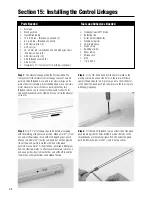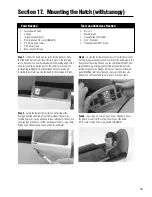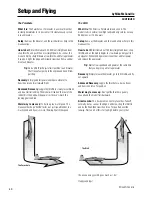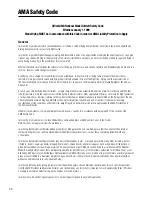
35
Step 5.
Make a 90-degree bend at the opposite (unthreaded)
end of each 12'' rod at the positions marked in Step 4. Trim the
bend section to a length of 1/8'' to 3/16'' (enough to fit in the hole
in the wood pushrod but not extend beyond the hole).
Step 6.
Trial fit the two long threaded rods into the hole on
either side of the wood pushrod (the 1
1
/
2
'' and 2'' marked end).
Trim off any excess rod that projects beyond the hole. You may
need to round out the holes slightly so the rods fit against the
wood pushrod.
Step 7.
When you are satisfied with the fit, mix approximately
1/4 ounce of 30-minute epoxy and apply to the holes and grooves
of the wood pushrod. Install the rods into the holes and wrap
securely with nylon thread. Coat with epoxy and allow to cure.
Step 8.
Cut the heat shrink tubing into two equal pieces. Slip
one onto the wood pushrod and threaded rods. Use a heat gun to
shrink the tubing into place.
Step 9.
If you have not cut out the openings for the elevator and
rudder linkages on each side of the fuselage rear, now is the time
to do so. They are located below the front of the horizontal
stabilizer. Both slots are approximately 1'' long. The elevator slot
is approximately 1
3
/
8
'' below the front of the horizontal stabilizer,
each side of the fuselage. The rudder pull-pull linkage opening is
located directly below the elevator linkage slot, along the red trim
line at the fuselage bottom.
Step 10.
Slide the elevator pushrod through the hatch opening
in the fuselage and into the tail section so that each rod exits at
the rear of the fuselage, through the elevator linkage slots.
Hint:
The elevator pushrod requires some bending of the
threaded rods that pass through the fuselage rear. The
illustration below gives an approximate idea of how to
bend the rods so they would exit the fuselage.
Attach a nut and a clevis to each elevator threaded pushrod end.
Screw in approximately 10 turns. Connect each clevis to the
outer hole of each elevator control horn. Adjustments to each
elevator position can be done by screwing the clevis in or out on
the threaded rods. The clevis should be secured to the control
horn with the metal clips provided with each clevis. This will
prevent the clevis from opening in flight.
Step 11.
With the pushrod attached to the elevators, adjust so
each elevator half moves the same. Tape the elevators in the
neutral position (centered to horizontal stablizer). Attach the
6'' threaded rod to the other end of the wood pushrod, threaded
end toward the elevator servo in the fuselage. Make sure the
elevator servo arm is centered. Thread a nut and clevis on the
threaded end of the 6'' rod and adjust the rod so the servo arm is
90 degrees to the elevator push rod. Adjust the 6'' rod’s position
on the wood pushrod until the correct length of the pushrod is
determined, i.e., the elevators at neutral, the length of the 6'' rod
should form a 90-degree angle with the clevis attached and the
servo arm centered. Once this length is adjusted by moving the
6'' rod on the wood pushrod, mark where the 6'' rod passes the
hole that was drilled in that end of the wood pushrod.
Step 12.
Remove the 6'' rod and make a 90-degree bend at the
mark made in step 11. Trim the bent end so it is 1/8'' long.
Remove the wood pushrod from the fuselage. Mix approximately
1/4 ounce of 30-minute epoxy and epoxy the 6'' rod into the
hole. Wrap with nylon thread. After the epoxy has cured, slip the
heat shrink tubing over the rod and shrink using
a heat gun.
Section 15: Installing the Control Linkages
CONTINUED
1''
30° Approx.
2''
Содержание EDGE 540
Страница 52: ...52 ...
Страница 53: ...53 Template Cut Out of Cowl Bottom MDS 1 48 ...
Страница 54: ...54 ...
Страница 55: ...55 ...
Страница 56: ... 2000 Horizon Hobby Inc www horizonhobby com ...
Страница 57: ...57 ...
Страница 58: ...58 ...
Страница 59: ...59 ...
















































